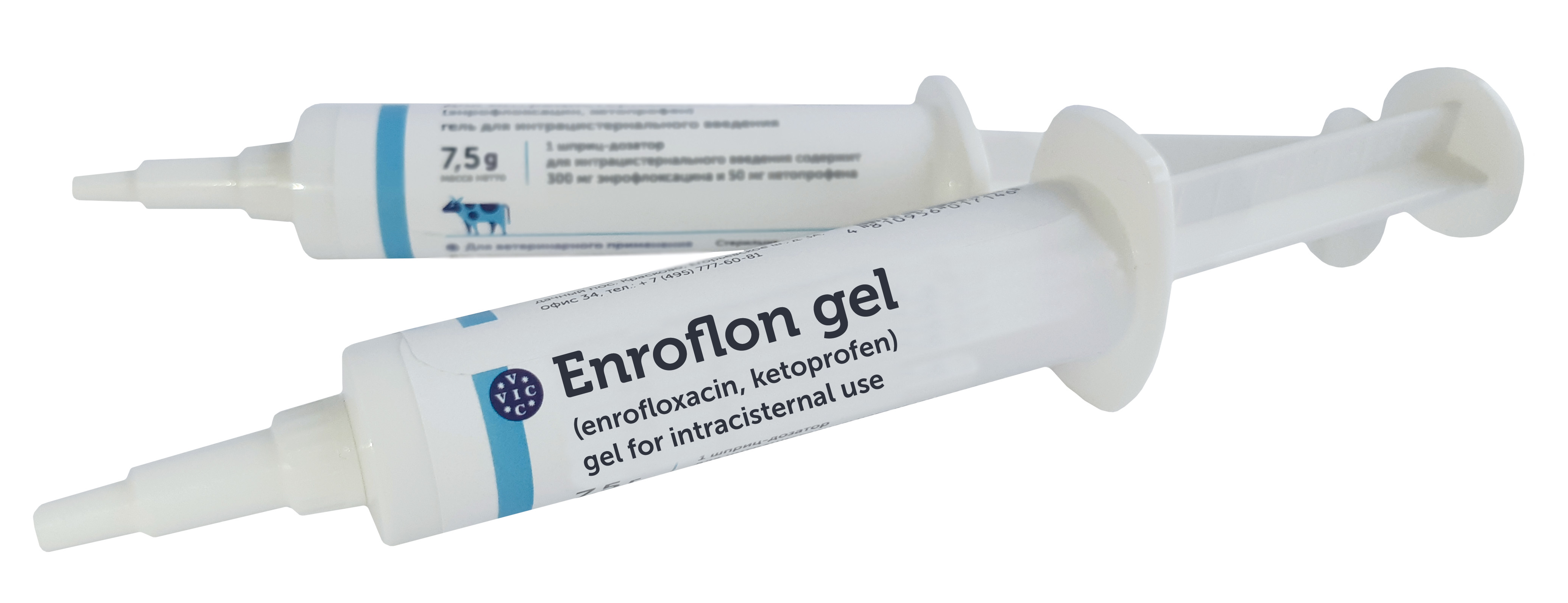Enroflon gel
Gel for intracisternal use

Specification
Enroflon gel for intracisternal use is a combined antibacterial drug, which consists of enrofloxacin (a fluoroquinolone) and ketoprofen (a non-steroidal anti-inflammatory drug). Enrofloxacin is a derivative of quinolocarboxylic acid, belongs to the 3rd generation Fluoroquinolones, and has a broad spectrum of activity against most gram-positive and gram-negative microorganisms, including Staphylococcus spp., Streptococcus agalactiae, Streptococcus uberis, Streptococcus dysagalactiae, Corynebacterium pyogenes, Escherichia coli, Pseudomonas aeruginosa, Bacillus spp., Pasteurella spp. and etc. Enrofloxacin inhibits bacterial DNA gyrase, disrupts DNA synthesis, growth and division of bacteria; causes pronounced morphological changes (including in the cell wall and membranes), which leads to rapid death of the bacterial cell. Ketoprofen is a derivative of propionic acid from the group of carboxylic acids, has anti-inflammatory, analgesic and antipyretic effects, is effective for the treatment of acute, subacute and chronic inflammation accompanied by a symptom of pain, reducing swelling and soreness that are characteristic of mastitis. The mechanism of action of ketoprofen is to suppress the synthesis of prostaglandins and thromboxane, by disrupting the metabolism of arachidonic acid. After intracisternal administration of the drug, the active substances are evenly distributed in the udder tissues and quickly reach therapeutic concentrations. The level of enrofloxacin in milk exceeds the minimum inhibitory concentrations for the main causative agents of mastitis during treatment and at least for a day after the last administration of the drug. Enrofloxacin is partially metabolized in the liver to form ciprofloxacin, which also has antibacterial activity. Fluoroquinolones are excreted from the body mainly with urine and bile. Ketoprofen is excreted from the body of animals mainly by the kidneys.
Indications
Enroflon gel for intracisternal use is used for treatment of subclinical mastitis of bacterial etiology in lactating cows.
Composition
One syringe dispenser for intracisternal administration contains 300 mg of enrofloxacin, 50 mg of ketoprofen and excipients (hydroxyethylcellulose, potassium hydroxide, acetic acid, 1,2-propylene glycol, thioglycerin, benzyl alcohol and water for injection).
Dosage
Before the administration of the drug, the infected quarter of the udder is completely freed from milk. The nipple is treated with an antiseptic wipe from the outside. If it is necessary to administer the drug into two or more nipples, a separate napkin is used for each of them. The cannula of the syringe dispenser is inserted into the nipple canal and, gently pressing on the piston, squeeze its contents into the infected quarter of the udder. After that, the tip of the syringe is removed, the tip of the nipple is squeezed with fingers for 1-2 minutes and the nipple is lightly massaged from bottom to top for better distribution of the drug. Enroflon gel for intracisternal use is administered to animals twice a day with an interval of 12 hours for 2-3 days.

